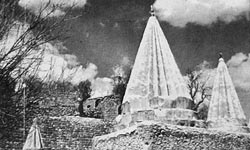Yazidism
Religion with around 700,000 members world wide (other estimates set this
as low as 100,000, but the higher figures are more likely). The largest
group of Yazidis live in Iraq, near Mosul, but there are small communities
in Syria, Turkey, Georgia, and Armenia.

Researches believe that the Yazidi creed has elements from Zoroastrianism,
Manicheism, Judaism, Christianity, and Islam. The two religious books of
the Yazidis, have Arabic text: Book of Revelation, and Black Book. The
Yazidis call themselves Dasin, while the term 'Yazidism' probably comes
from the Persian word 'îzed', 'angel'. The name Yazidism is moreover
connected to the 6th caliph, Yazid (680-83, 60-64 H), from Shi'i point of
view one of the world history's most hated men, and highly disliked by
most Sunnis, too. But there is little evidence showing what role Yazid
have played in the founding, or development of Yazidism.
THEOLOGY
The Yazidi pantheon has God on top, but he is only the creator, and is no
longer an acting force. The acting forces is represented by Malak Ta'us
and Shaykh Adii. Shaykh Adii can have been caliph Yazid (there are many
theories here), a man risen to divinity through transmigration, and is now
an acting and good deity.
Shaykh Adii is acting in a cooperation with Malak Ta'us, the peacock angel
that have fallen into disgrace, but who repents.
Malak Ta'us filled 7 jars of tears through 7,000 years. His tears were
used to extinguish the fire in hell. Therefore there is no hell in
Yazidism. Yazidism has 6 other minor deities, which are also honored.
CULT and WORSHIP
The prayer in Yazidism must be performed in good distance from non-Yazidis,
twice a day, and in the direction of the sun. The prayer is dedicated to
Malak Ta'us. Saturday is the day of rest, but it is Wednesday that is the
holy day. In December a three days fast is performed.
There is an annual pilgrimage to the tomb of Shaykh Adii, north of Mosul
in Iraq, through 6 days in late August. This pilgrimage is the most
important ritual of Yazidism. Central to this celebration are bathing in
the river, washing of figures of Malak Ta'us, processions, music, hymns,
ecstatic songs, and dances performed by the priests. Other elements are
lighting of hundreds of oil lamps at the tombs of Shaykh Adii and other
saints' tombs, offerings of special foods and cooking of a sacrificed ox.
Important parts of the rituals here have never been seen by outsiders, and
are therefore unknown.
Childhood baptism is important, and is performed by a Shaykh, a religious
leader. Circumcision for boys is performed soon after the baptism, but is
not compulsory. Burials are done immediately after death, and the hands
are crossed, pointing in eastern direction.
ORGANIZATION
The Yazidis are organized much like the Kurds, with tribes headed by a
chief. There are very strong ties between the laity and the religious
leaders. Almost all Yazidis speak Kurdish. The Yazidis practice no
intermarrying with other Kurds, and have no communion with them.
The Yazidis believe that they are the descendants of Adam only, while the
rest of the world are descendants of Eve, hence inferior. It is impossible
to convert to Yazidism, you must be born one. The strongest punishment
among Yazidis is expulsion, which means that your soul is lost forever.
Monogamy is practiced, but the chief has the right to take several wives.
Divorce is difficult to get, as this only comes from adultery, and three
witnesses are needed. But if a husband stays abroad for more than a year,
he is automatically divorced from his wife, and has also lost the right to
remarry inside the Yazidi community.
DEVIL WORSHIPPERS?
The reason for the Yazidis reputation of being devil worshipers, is
connected to the other name of Malak Ta'us, Shaytan, the same name as the
Koran's for Satan.
But there is little suggesting that the Yazidis worships Malak Ta'us as if
he was equal to the Koran's or the Bible's devil. The Yazidis have never
been regarded as Ahlu l-Kitab, people of the book, and the they have
suffered much hardship from their Muslim neighbors.

